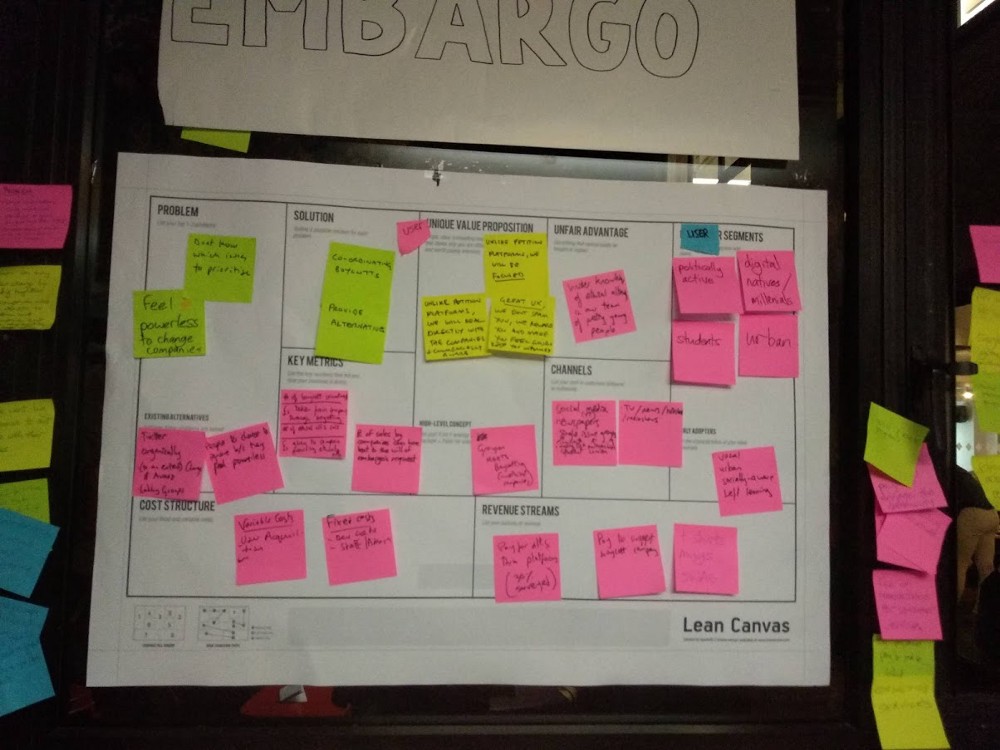How to convert an idea into a business
Share:
When people find out that I co-founded a company, they often tell me that they have their own idea for a startup. They get super excited to share this idea with me, telling me about how big it could be, how it could change people’s lives, how it’s something that’s really needed in the world.
But then they don’t know where to go with it.
At this point, I usually point them in the direction of the Lean Startup Canvas. (Or, if I have time, I offer to facilitate a half hour workshop where we fill out the canvas together.)
The lean startup canvas is a one-page document that lays out all the basics of your startup. This includes writing out a summary of the problem and the solution, a simplified business model, the components of a go-to-market strategy, and the metrics to track product-market fit.
It’s better than writing a full business plan. Business plans, for startups, are a waste of time. One of the core tenets of a startup is staying lean: moving fast, making mistakes, learning as you grow and failing forwards. All of this is done in service of finding a scalable business model. You make assumptions, and then try and validate those assumptions as quickly as possible, so you can adapt the business model.
Spending months researching and documenting a business plan is therefore a waste of time: it leaves you tied to a rigid set of rules.
Another benefit is that:
“You can capture the same level of information in a one page business model and have it be more portable and accessible. But more importantly, it’s great practice for articulating your hypotheses — whether you’re pitching a customer or investor, you only get a tiny slice of time to make your case.”
— Ash Maurya
The idea of stripping a business plan into a one-pager came from Alexander Osterwalder’s Business Model Canvas. This was adapted by Ash Maurya to the Lean Startup Canvas. Both are widely used, but the former is better for established businesses who have validated their core business model. The latter is better for startups, as it is end-user focussed and directs attention to one core problem, instead of worrying about multiple activities and partners.
Since then, it’s been championed and used in multiple places. I first learnt about it from Techstars, a global startup accelerator that champions early-stage startups and entrepreneurs. Techstars facilitates a startup conference called Startup Weekend, where teams come together to create and pitch to a panel of judges their startup in 54 hours, with big prizes for the winning teams.
Each weekend started by creating the canvas, then validating the riskiest assumptions that arose by talking to as many target users as possible, and creating a simple prototype of the solution.

The canvas for our team’s startup at a Social Impact Startup Weekend in London in 2018. Embargo was an idea for a platform to manage co-ordinated boycotts and provide alternatives to unethical brands.
I’ve made these canvases at multiple Startup Weekends; when working on personal startup ideas; when facilitating sessions for friends’ ideas (most recently a spice subscription box idea); when tutoring applicants for a business entrepreneurship degree; and for my own company, Sound Off. I can’t recommend it highly enough.
Creating a lean startup canvas shouldn’t take long. 20 minutes is the maximum amount of time to spend. If you’re making one in person, grab a box of post-its and a box of Sharpies and go wild with your co-founders. If you’re doing it remotely, you can all jump into this shared Figma file. (Figma is a remote-friendly collaborative design tool.)
Fill out the blocks, following the numbered order. The left half of the canvas concerns your product, and the right half concerns the market. Hence, the whole thing is an early indicator towards product/market fit.
Then, when it’s done, pin it up on the wall in a prominent place. It’s a living document; don’t just do it and forget about it. As your startup grows, come back to it and change things around based on what you learn.
Or… you may find in the process of doing it that the idea isn’t quite right. Problem/solution fit is the most important thing for a startup. If making a lean canvas has shown you that your problem isn’t an actual problem for a group of users, then, no matter how great your revenue strategy or marketing plan is, you’ll never gain traction. In which case, it’s good you found this early, and it’s time to pivot your idea.